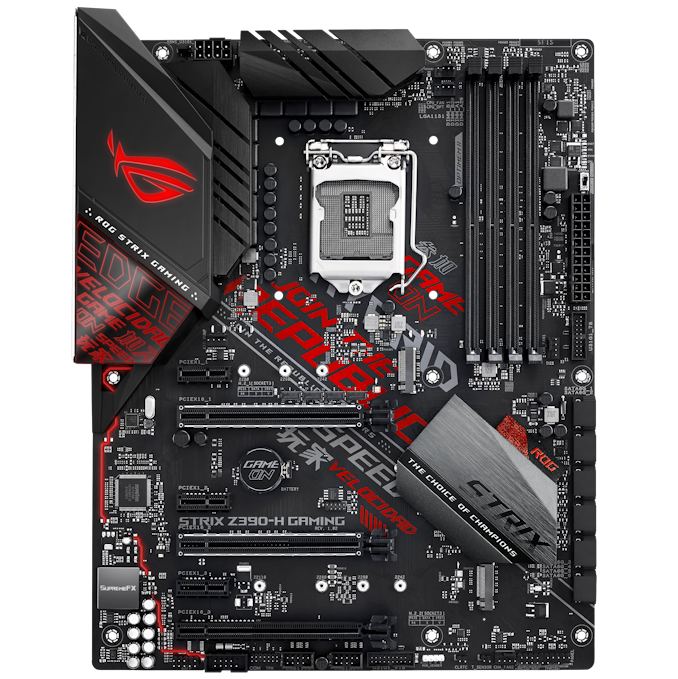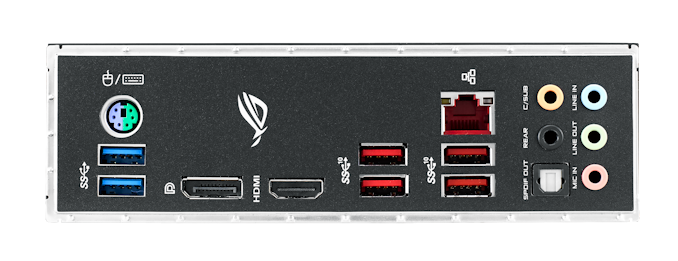Intel Z390 Motherboard Overview: 50+ Motherboards Analyzed
by Ian Cutress & Gavin Bonshor on October 8, 2018 10:53 AM EST- Posted in
- Motherboards
- Intel
- MSI
- Gigabyte
- ASRock
- EVGA
- Asus
- NZXT
- Supermicro
- Z390
ASUS ROG Strix Z390-H Gaming
Although the ROG Strix Z390-H retains the same PCB layout as the Strix Z390-E model, the visuals are much more aggressive with a red and black theme throughout; the Edge branding on the rear panel cover matches this particular color scheme. The Z390-H has three full-length PCIe 3.0 slots which operate at x16, x8 and x4 respectively, with the top two also featuring a coating of metal slot reinforcement protection. Like the Z390-E, the Z390-H has three available PCIe 3.0 x1 slots.
Storage capability is rather standard as far as Strix branded 300 series boards go with two M.2 slots available, with one having just PCIe 3.0 x4 support and the other allowing for SATA based drives to be used too. The six available SATA ports are placed differently on the Strix Z390-H with all six ports being aligned vertically in single and an individual array. RAM support is standard for an ATX sized board with four available slots with support for DDR4-4266 and a total combined capacity across all slots of up to 64 GB.
A slightly less comprehensive set of rear panel connectors marks a shift in the ASUS crammed rear panels, but still is remarkably impressive overall as the Strix Z390-H Gaming has a total of four USB 3.1 Gen2 Type-A and two USB 3.0 Type-A ports. In addition to this is a pair of video outputs with an HDMI and DisplayPort both being featured, with a PS/2 combo port, single Intel I219V Gigabit powered LAN port and a set of onboard audio connectors controlled by a ROG SupremeFX S1220A audio codec.
The ASUS ROG Strix Z390-H Gaming has an unknown pricing as of yet and is one of the only red and black themed boards on the whole of the Z390 chipset. The ROG logo on the rear panel is RGB and offers compatibility with the ROG AURA Sync RGB software, with the most notable point is the board's inclusion of four USB 3.1 Gen2 Type-A ports; sorry, no USB Type-C whatsoever on the Z390-H Gaming.












79 Comments
View All Comments
Valantar - Wednesday, October 10, 2018 - link
That would be pretty shocking, yeah, but the sheer size of that lump of metal still has me a bit worried. Guess that's what you get when you try to squeeze power delivery for a CPU that (likely) pulls >300W when overclocked into an ITX board (and refuse to use riser boards like before, for some reason).FXi - Monday, October 8, 2018 - link
The power feed also changed with z390 I believe at least in the Asus models it did. The power feed of the 370 was "enough" to drive the newer 9700/9900 but there is a difference there that may impact enthusiasts. I don't think it enough to warrant an upgrade but something to consider.Also people should remember that while it is still a bit of a ways off, wifi is going to change to Wifi6 or 802.11ax starting now and probably seeing much of the changeover during 2019/2020 depending on adoption choices. And there is also pci-e 4.0 to consider next year probably that should be thought about before people do "marginal" upgrades from 370 era chipsets.
FXi - Monday, October 8, 2018 - link
Silly thing posted in edit window. Sorry power delivery and other points covered by you. Would have edited if I could have found that optionDanNeely - Monday, October 8, 2018 - link
Other things to look forward to in the next few generations are: Less-hacky USB3.1 implementations (eg this articles speculation that a 10g port will need to eat 2 HSIO lanes instead of 1, and still needing an extra chip to support USB-C). Spectre/Meltdown fixes in hardware. A reduced DMI bottleneck between the CPU and chipset (either just from upgrading the link to PCIe4/5, moving some of the peripheral IO onto the CPU, or both.Valantar - Wednesday, October 10, 2018 - link
Considering that the maximum theoretical bandwidth of PCIe 3.0 x1 is 984.6MB/s, you _need_ two PCIe lanes (and thus two HSIO lanes) for a USB 3.1G2 (1.25GB/s) controller unless you want to significantly bottleneck it. That's not "hacky", that's reality, even if this leaves a lot of bandwidth "on the table" if this only powers a single port (which it rarely does, though, and given that a full load on two ports at one time is unlikely, running two 1.25GB/s ports off two .99GB/s lanes is a good solution).Moving DMI to PCIe 4.0 will be good, though, particularly for multiple NVMe SSDs and >GbE networking.
DanNeely - Wednesday, October 10, 2018 - link
Splitting the traffic over 2 HSIO lanes is a hack because it'd require something to split/combine the traffic between the chipset and usbport. That in turn has me wondering if the speculation about the implementation being done that way is correct, or if the Z390 has 6 HSIO lanes that can run 10Gbps instead of the 8 that the rest top out at for PCIe3repoman27 - Thursday, October 18, 2018 - link
The implementation is absolutely not done that way. HSIO lanes are simply differential signaling pairs connected to a PCIe switch or various controllers via a mux. The PCH has a 6-port USB 3.1 Gen 2 xHCI, which can only feed 6 HSIO muxes. The back end of that xHCI is connected to an on-die PCIe switch which in turn is connected to the DMI interface. That DMI 3.0 x4 interface is already massively oversubscribed, but it is at least equivalent to a PCIe 3.0 x4 link, which is the most bandwidth that can be allotted to a single PCH connected device.Srikzquest - Monday, October 8, 2018 - link
HDMI 2.0 is available in Asus and Gigabyte's ITX boards as well.gavbon - Tuesday, October 9, 2018 - link
Thank you Srikzquest; updated the tables, obviously missed this yesterday :) - Thanks againHickorySwitch - Monday, October 8, 2018 - link
Correction:https://www.asus.com/us/Commercial-Servers-Worksta...
It says under "Specifications" that the board sports HDMI 2.0[b?]